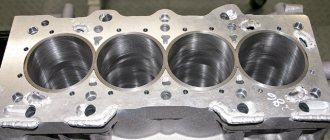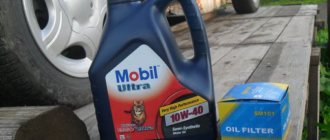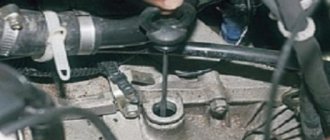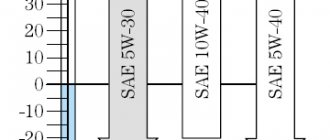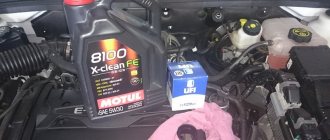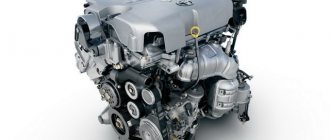The creation of budget power units attracts attention not only with their low price and modest fuel consumption. The modern buyer has become much more demanding and takes into account all the characteristics of the engine. The MR479QA motor is one of the best developments from the Geely concern. The company's products occupy a huge share of the Chinese market and are known beyond its borders. The engine characteristics provide the car with good driving dynamics, and the availability of spare parts will make any major repair possible.
Description and performance indicators of the MR479QA motor
Advancement in the automotive market is impossible without the development of modern engines. With the release of the MR479QA power plant, Geely showed the seriousness of its intentions to expand sales to the markets of Europe and Asia. Carefully calculated power ratings and maintainability have made engines made in China quite reliable for long-term operation. This engine uses BOSCH electronic control and a lot of technical solutions from Toyota.
The parameters of the MR479QA engine allow you to experience all the benefits of high-tech production. The power plant has much in common with the 5A-FE engine used in the Toyota Corolla, but the Geely MR479QA cannot be called a full replica of the Japanese engine. Most of its features have been changed to avoid lawsuits, but the internals and attachments are virtually identical. Among the features of the MR479QA are its low cost and low noise level in operation.
MR479QA Engine Specifications
All indicators of the power plant are precisely calculated and allow you to feel confident when driving the car. The engine design is a four-cylinder in-line design with a fuel injection system. The vertical cylinder arrangement and DOHC gas distribution system complement the engine's characteristics. This technology allows the use of 2 camshafts to service the cylinder head. The crankshaft in the MR479QA engine is mounted on reinforced main bearings and has rigid fixation to prevent axial vibrations.
The MR479QA engine has valve adjustments that must be performed regularly to prevent more serious damage. The cylinder head itself is made of aluminum alloy, and the intake and exhaust ports are on opposite sides. The remaining technical characteristics also deserve a little attention.
- The cooling system is closed and has no direct communication with the external environment. To prevent pressure drops, an expansion tank is used. The pump is equipped with a drive coming from the crankshaft, which ensures the circulation of coolant;
- Lubrication system - combined design guarantees a stable supply of oil under pressure for all components operating under load. Oil is supplied to the remaining elements by gravity or splashing;
- Flywheel - has a crimped toothed rim, which serves to start the engine with a starter. The flywheel itself is made of cast iron;
- Ignition is built on microprocessor control, ensuring high accuracy. The ignition module does not require adjustment, and spark plugs for the MR479QA engine can be used of iridium or conventional type.
The timing system is typical for an internal combustion engine of this design and uses a belt drive. Despite the similarity with the 4A-FE engine, spare parts from Toyota are not suitable for all, and you should carefully study the service manual or buy original parts.
Geely MR479QA engine maintenance
To create optimal conditions for engine operation, all recommendations of the manufacturer should be followed. Such information can be found in the user manual, indicating the timing and required maintenance procedures. With significant mileage, you should pay closer attention to the car, and a simple replacement of the valve stem seals can protect the cylinder head from major repairs. Items such as the air filter or fuel system also require maintenance that should not be forgotten.
For any car, changing the oil is of great importance. The driver should definitely know what kind of oil can be poured into the engine. In this regard, Geely is quite universal and the oil for MR479QA is 10w40 and 10W30. In winter, it is also possible to use 5w30. The engine manufacturer recommends replacing it after 10 thousand km, but the real need may arise after 5-7 thousand km. Oil control can be easily done using a dipstick, which will show its level and degree of production.
Replacement instructions
During the operation of the car, the filter element gradually becomes dirty, so it needs to be changed. Changing the oil filter is usually done when the engine oil is changed. The frequency of replacement is affected by the design of the engine and the operating conditions of the vehicle. It is recommended to carry out maintenance to change the oil after 15 thousand km; if the car is under constant load, then the lubricant is changed after 7 thousand km.
What will you need?
The lubricant replacement procedure is carried out on a lift, inspection pit or overpass. If they are absent, the machine is raised using a jack and placed on supports. From tools and materials you should prepare:
- new consumables;
- a set of keys;
- a special puller for unscrewing the old filter;
- container for waste liquid with a volume of 5 liters;
- clean rags.
Geely oil filter
You can use an old canister as a container.
Step-by-step instruction
The filter is located on different car models in different places, sometimes it is difficult to get to it and you need to use a special puller to unscrew it. The replacement procedure consists of the following steps:
- Before changing the oil filter, you need to drain the old fluid from the engine. To do this, you need to unscrew the plug on the drain hole, placing a previously prepared container under the engine. The liquid is drained within 10 minutes.
- To prevent dirt from getting on the threads that connect to the block, you need to wipe the area between the filter and the cylinder block with a clean rag.
- When unscrewing the old filter element, you need to apply a long force. It is better to use a special key for unscrewing.
We unscrew the old oil filter.
They can be toothed, universal with paws, or chain. For the Geely MK Cross, a universal one with paws is better suited. As a last resort, you can use a long screwdriver or any other long, sharp tool. Use them to pierce the housing and, using the tool as a lever, unscrew the old filter. - After removal, the product should be inspected. If there is no rubber seal on it, it may have remained in place, it should be removed.
- Before installing a new filter, lubricate the rubber seal around the perimeter with new oil.
Lubricate the rubber seal - To reduce oil starvation, before installation, you need to pour 400 to 500 ml of oil liquid into the oil filter.
- The oil filter installation site should be cleaned of dirt so that it does not get into the new oil.
- We tighten the new consumable by hand until it touches the base of the cylinder block.
- The installed oil filter must be tightened ¾ of a turn; you can use a puller.
- After installing the oil filter, complete the lubricant replacement procedure.
- Screw the plug onto the drain hole with a new sealing washer.
- Then you need to open the hood and unscrew the cap on the filler hole.
- After this, you should fill in new oil and check the oil level.
Fill in new lubricant
It should be between the maximum and minimum marks. - At the final stage, you need to start the engine and let it run for 10 minutes. After turning off the engine, you need to check for leaks on the drain plug and oil filter. If there is a leak, tighten the product.
- Next, check the oil level again. If there is not enough lubricant, you need to add it.
To avoid counterfeits, it is better to purchase the Geely MK – Cross oil filter from official dealers. With proper care and timely maintenance, the car will last a long time without major repairs.
Malfunctions of MR479QA series motors
There are shortcomings in the operation of every engine, and Geely power units are no exception. The largest number of malfunctions is caused by rapid wear and tear of the vehicle's chassis and engine. Its resource is much less than that of European-made cars, although absolutely all companies are not too interested in cars with a million-dollar resource. The advantage of the MR479QA is that even if the belt breaks, the valve does not bend, and the car itself can be restored after almost any breakdown.
Each engine has a rather complex design and you should not interfere with the operation of the motor with your own hands. Geely can replace almost any attachment, which allows you to restore the engine in case of a wide variety of faults.
Proper preparation for changing the oil in a manual transmission and a list of necessary tools
Preparing to change the oil in a manual transmission involves choosing the right tools and following safety precautions.
List of necessary tools for changing the oil in a manual transmission on a Geely MK:
- a set of wrenches (including a 12 wrench);
- a simple screwdriver;
- pliers;
- pharmaceutical syringe;
- workwear;
- empty container for draining;
- rags.
When changing oil, safety precautions must be observed. It is replaced only 10-15 minutes after stopping the engine. This will prevent unwanted consequences such as burns. Additionally, special clothing and rubber gloves are required. Waste oil liquid is unsafe, so protective clothing and gloves will prevent unpleasant consequences if the liquid gets on your skin.
Engine tuning options
Upgrading the engine on Geely cars allows you to increase power and torque. For such tuning, electronic control optimization is usually used. Boosting a Chinese car by making physical changes to the operation of the internal combustion engine is not always advisable. Such intervention can lead to rapid wear of engine parts and the money spent will not yield results.
For the MR479QA engine, a tuning chip is sufficient, which guarantees a minimum increase in power within 10%. Carrying out such an operation does not take much time and does not require partial disassembly of the machine. Correct tuning does not lead to an increase in fuel consumption, which will be important for any car owner. The decision to carry out such modernization should be based on the need for increased power.
Geely MK changing gearbox oil
Turbine repair in Lviv - To change the oil, you need to clean the inspection hole plug and unscrew it. It is necessary to make sure that the gearbox crankcase is completely filled with motor oil to the required level.
Connecting to the AIR affiliate - Changing the oil and cleaning the breather in a manual gearbox If the gearbox does not have a plug, then you can add it through the dipstick hole. To do this, arm yourself with an ordinary large medical syringe, use it to draw up oil and inject it into the hole.
In cars that do not have a dipstick or filler plug, it is necessary to add oil through the sensor holes. As a rule, this is a speed sensor or a reverse sensor. When topping up, the main thing is not to overdo it, since excess lubricant can lead to rapid failure of the gearbox. There is enough oil if its level is at the level of the filler box or when it is opened, a little oil comes out of it.
It should be noted that oil must be purchased 0.5 -1 liter more than the required amount, so that it can be topped up if it leaks during replacement. It is necessary to change the box immediately after purchase. I have changed a lot on Jeeps and there are terrible things that happen there.
I changed it with flushing and filled it with 75W90 GL-4, it’s important to know exactly 4 and I advise you to add two tubes of molybdenum of 20 grams each. Let's think about it: is it even worth changing the oil in a manual transmission?
How to check the fluid level in the box?
Or, nevertheless, this Oil should be exactly as much as is required in the filling containers or in the control plug, and the excess is not Ice. Well, as for the performance, I can’t say if the oil is of the same viscosity, then there’s not much to change.
How to quickly determine the oil level in a manual transmission or gearbox. The video blog of the “Levsha” channel shows routine garage chores. Our video is not educational. Here is the Geely MK Cross for now.
Change the oil in the gearbox and engine. Correctly changing the oil in the gearbox Clean the inspection hole plug and unscrew it. Changing the Geely MK oil 1. Geely Emgrand Geely Emgrant changing the oil in the gearbox There is enough oil if its level is at the level of the filler box or when it is opened, a little oil comes out of it.
Do I need to change the oil in a manual transmission? Just about the complicated stuff. You have to change it in the box immediately after the purchase. I changed a lot on the Jills and there is such a thing that happens there, which is terrible.
How to quickly determine the oil level in a manual transmission or gearbox. There should be exactly as much oil as is indicated in the filling containers or in the control plug, and there should be no excess. On the topic: Interchangeability of spare parts for Geely Mk.
Vehicles with MR479QA engine
Geely produces a fairly large range of cars that are used in various countries. The release of the MR479QA engine made it possible to update the line of 1.5 liter engines with modern models of power plants. The characteristics of such an engine are well balanced for city driving and will allow you to feel the pleasure of driving on the highway. The installation of such a motor has been carried out since 2003 and does not stop today.
The Geely MR479QA engine, although it does not have a long service life, turned out to be quite successful. Models BL, CK, MR and MK can boast of such a power plant. The Chinese company installs engines with different displacements, but with a similar internal combustion engine design, into its cars. Although the MR479QA powertrain does not have huge power, its potential is enough for a budget car.
Characteristics of the MR479QA power plant
An economical engine with good driving performance will be convenient for various purposes. More complete characteristics are noted in the table and everyone can independently evaluate the Geely engine.
| Production | Geely |
| Engine make | MR479QA |
| Years of manufacture | 2003 — … |
| Cylinder block material | cast iron |
| Supply system | injector |
| Cylinder head | DOHC |
| Number of cylinders | 4 |
| Valves per cylinder | 4 |
| Piston stroke, mm | 77 |
| Cylinder diameter, mm | 78,7 |
| Compression ratio | 9,8 |
| Engine capacity, cc | 1498 |
| Engine power, hp/rpm | 94/6000 |
| Torque, Nm/rpm | 128/3400 |
| Fuel | gasoline A 92 |
| Environmental standards | Euro II |
| Engine weight, kg | n.d. |
| Fuel consumption, l/100 km | 4.7 — 6.3 |
| Cooling system | forced |
| Engine oil | 10w40 |
| 10W30 | |
| 5w30 | |
| How much oil is in the engine, l | 3 |
| Cylinder operating order | 1-3-4-2 |
| Turbine | No |
| Oil change carried out, km | 1500 is better than 7500 |
| Oil consumption, ml/100km | up to 300 |
| Engine life, thousand km | |
| - according to the plant | n.d. |
| - on practice | 100+ |
| Tuning | |
| — potential | + |
| - without loss of resource | n.d. |
| The engine was installed | GEELY BL |
| GEELY CK | |
| GEELY MR | |
| GEELY MK |
The power unit has a lot of positive characteristics that indicate its reliability. Stable compression performance and well-chosen volume will ensure the practicality of such an engine. Good driving dynamics and reliability of the fuel system make choosing a car with this engine quite acceptable. Although its operation is not designed to last for several decades of intensive work, it will be sufficient for the needs of most drivers.
The Geely MK car is equipped with a transversely mounted four-stroke four-cylinder petrol injection 16-valve engine with a displacement of 1.5 liters.
The engine is with in-line vertical cylinders, liquid cooling.
Camshaft
The exhaust valves are driven by the timing belt, the intake camshaft is driven by the exhaust camshaft using helical gears mounted on the camshafts.
Replacing the timing belt, see Replacing the exhaust camshaft oil seal, see Replacing the camshafts, see The cylinder head
is made of aluminum alloy according to a transverse cylinder purging pattern (intake and exhaust ports are located on opposite sides of the head). Valve seats and guides are pressed into the head. The intake and exhaust valves have one spring each, fixed through a plate with two crackers. A non-shrinkable metal-reinforced gasket is installed between the block and the head. In the upper part of the cylinder head there is a common bed of bearing supports for two camshafts (intake and exhaust). The upper bed covers of the bearing supports are attached to the block head with bolts that secure the bed covers to the base of the bed. The holes of the sliding bearing supports (bed) are processed together with the covers, so the covers are not interchangeable; each cover is marked with a serial number. Replacing valve stem seals, see Replacing the cylinder head gasket, see Replacing cylinder head cover gaskets, see Installing the piston of the first cylinder to the TDC position of the compression stroke, see Checking and adjusting the clearances in the valve drive, see
Cylinder block
The engine is a single cast iron casting that forms the cylinders, cooling jacket, lubrication system and five crankshaft bearings. At the bottom of the block there are five beds of main bearings. The cylinder block has special bosses, flanges and holes for fastening parts, assemblies and assemblies, as well as channels for the main oil line. Checking, adjusting and replacing drive belts, see
Crankshaft
rotates in main bearings having thin-walled steel liners with an anti-friction layer. The engine crankshaft is secured against axial movements by two half-rings installed in the grooves in the bed of the middle main journal bearing. Removing, troubleshooting and installing the crankshaft, see Replacing crankshaft oil seals, see
Flywheel
cast iron, mounted on the rear end of the crankshaft through a mounting sleeve and secured with six bolts. A toothed rim is pressed onto the flywheel to start the engine with a starter. The flywheel has a gear ring for the crankshaft position sensor. To replace the flywheel, see
Pistons
made of aluminum alloy. On the cylindrical surface of the piston head, annular grooves are made for one oil scraper ring and two compression rings. The pistons are additionally cooled by oil supplied through a hole in the upper end of the connecting rod and sprayed onto the piston crown. For defective parts of the connecting rod and piston group and cylinder block, see Replacement of parts of the connecting rod and piston group, see
Piston pins
installed in the piston bosses with a gap and pressed with an interference fit into the upper heads of the connecting rods, which with their lower heads are connected to the connecting rod journals of the crankshaft through thin-walled liners, the design of which is similar to the main ones.
Connecting rods
steel, forged, with an I-section rod.
Lubrication system
combined: the most loaded parts are lubricated under pressure, and the rest - either by directed splashing or by splashing oil flowing from the gaps between the mating parts. Replacing the oil sump seal, see Replacing the oil and oil filter, see Replacing the oil pump, see Replacing the interior heater valve, see
Crankcase ventilation system
The closed type does not communicate directly with the atmosphere, therefore, simultaneously with the suction of gases, a vacuum is formed in the crankcase under all engine operating modes, which increases the reliability of various engine seals and reduces the emission of toxic substances into the atmosphere.
Cooling system
The engine is sealed, with an expansion tank, consists of a cooling jacket made of casting and surrounding the cylinders in the block, combustion chambers and gas channels in the cylinder head. Forced circulation of coolant is provided by a centrifugal water pump driven from the crankshaft by a poly-V-belt, which simultaneously drives the generator pulley. To maintain the normal operating temperature of the coolant, a thermostat is installed in the cooling system, which closes a large circle of the system when the engine is not warmed up and the coolant temperature is low. Replacing the expansion tank see Replacing the water distribution box see Replacing the thermostat see Replacing the water pump see Replacing the electric radiator fan see Replacing the radiator see Replacing the coolant see
Supply system
The engine consists of an electric fuel pump installed in the fuel tank, a throttle assembly, coarse and fine fuel filters, fuel lines and injectors, and also includes an air filter. Replacement of thermal shields of the exhaust system, see Replacement of the main muffler, see Replacement of the additional muffler, see Replacement of the exhaust pipe, see Replacement of the exhaust manifold, see Replacement of suspension cushions of the exhaust system, see Replacement of the throttle drive pedal, see Replacement of the throttle drive cable, see Replacement idle speed control see Replacing the throttle assembly see Replacing the air filter housing see Replacing the air filter see Replacing the intake manifold gasket see Replacing the canister purge solenoid valve see Replacing the fuel vapor recovery system canister see Replacing the filler pipe see Replacing the fuel tank see Replacing and checking injectors see Replacing the fuel pressure regulator see Replacing the fuel rail see Replacing the fuel filter see Replacing the fuel pump see Checking and reducing pressure in the power system see
The design of the intake manifold with independent long channels allows the use of the effect of inertial charging.
Ignition system
microprocessor engine, consists of a four-terminal ignition coil (module), high voltage wires and spark plugs.
The ignition module is controlled by the electronic unit (controller) of the engine management system. The ignition system does not require maintenance or adjustment during operation.
Power unit
(engine, clutch and gearbox) is installed on three supports with elastic rubber elements: two side ones (right and left), which absorb the bulk of the power unit, and a rear one, which compensates for the torque from the transmission and the loads that arise when starting the car, acceleration and braking. Replacement of engine mudguards, see Replacement of engine mounts, see.
| MR479QA Specifications | |
| engine's type | 4-stroke, in-line 4-cylinder, 16-valve, water-cooled, dual counter-rotating camshafts |
| Combustion chamber type | Wedge-shaped |
| Inner diameter of the cylinder, mm | 78,7 |
| Piston stroke, mm | 77 |
| Cylinder volume, l | 1,498 |
| Compression ratio | 9,8 |
| Compression pressure (compression), kPa, not less | 980 |
| Permissible pressure difference in cylinders, kPa, no more | 100 |
| Oil volume, l | 3.0 |
| Fuel | Unleaded gasoline with an octane rating of at least 93 |
| Cylinder operating order | 1-3-4-2 |
| Shaft rotation direction (front view) | Clockwise |
| Lubrication system | Spray under pressure |
| Cooling system | Forced type |
| Thermostat valve opening temperature, °C | 82 |
| Full opening temperature of the thermostat valve, °C | 95 |
| Crankshaft rotation speed corresponding to maximum power, min-1 | 6000 |
| Maximum power, hp | 94 |
| Maximum torque at rpm, Nm | 128 |
| Crankshaft rotation speed corresponding to maximum torque, min-1 | 3400 |
| Idle speed, min-1 | 800±50 |
| Intake valve clearance on a cold engine, mm | 0,20±0,03 |
| Valve clearance of the exhaust valve on a cold engine, mm | 0,30±0,03 |
| Engine (front view): 1 — drive belt for generator and water pump; 2 — bracket for fastening the right suspension support of the power unit; 3 - generator; 4 — oil filler plug; 5 — throttle assembly; 6 - high voltage wire; 7 — cylinder head cover; 8 — intake manifold; 9 — cylinder head; 10 — inlet pipe of the engine cooling system; 11 — ignition module; 12 — water distribution box; 13 — crankshaft position sensor; 14 — left suspension support of the power unit; 15 — working cylinder of the hydraulic clutch release; 16 — control oxygen concentration sensor; 17 — exhaust manifold; 18 — oil filter; 19 — oil sump; 20 — air conditioning compressor; 21 — air conditioning compressor drive belt |
The information is valid for MK models from 2006 to 2020, and for MK Cross models from 2011 to 2020.
The engine is the heart of the car. It does not forgive low-quality spare parts, consumables and unqualified service. Therefore, every car enthusiast is primarily interested in the reliability and durability of the engine.
The engine of the Geely MK Cross is a variation of the Toyota 5A-FE
, purchased by the company under license. It was installed on the Toyota Corolla A100 - the standard of reliability and quality of the Japanese automobile industry. With timely maintenance, this unit could easily cover a million kilometers.
For the Chinese market, engines of 1.8 and 1.3 liters are installed. But only the version with a gasoline engine with a volume of 1498 cubic meters (94 hp) is supplied to Russia. It is this that will be discussed further.
Replacing the air filter on Geely MK
If it is necessary to replace the air filter on a Geely MK car, the car owner does not have to contact a car service center, wasting time and money. By following the recommendations below, owners of a Geely MK car will be able to perform the necessary manipulations on their own.
Signs that replacement is needed
The reasons leading to filter contamination may be different. The air sucked in by the engine contains dust, dirt, and sand.
It settles on the car's air filter, which prevents debris from entering the engine and disrupting the work process. Also, oil from the system can get into the Geely MK air filter, which affects its throughput.
Oil enters the filter element due to wear of the piston rings or due to problems with crankcase ventilation.
If the car air filter is significantly clogged, signs of the need to replace the element appear:
- fuel consumption increases, the engine, due to a clogged filter element, receives insufficient oxygen necessary to burn the combustible mixture;
- there are problems starting the engine;
- The internal combustion engine loses power, energy consumption for suction of air flow increases;
- the exhaust contains a large percentage of impurities.
Based on the presence of these signs, the vehicle owner can determine when to change the air filter of his car.
Replacing the air filter on Geely MK Cross
Replacing the Geely MK Cross air filter is done in the same way as for the Geely MK. The location of the air filter in these models is similar; the design features of the unit have pronounced similarities. The air filter element box is located in the upper left part of the engine compartment.
Filter selection
Before carrying out the procedure, you must purchase a new filter element. Every car owner should know how to choose the right car air filter.
An original part from the manufacturer Geely MK is best; you can also choose cheaper types of filters with parameters suitable for Geely in a special catalog.
Cabin or fuel filters are selected in the same way.
Replacement steps
The step-by-step instructions below describe in detail how to correctly change the air filter on a Geely MK with your own hands. It is enough for the car owner to strictly follow the sequence of actions, then he will get an excellent result of his work.
The work is carried out in the following order:
- Open the hood and find the filter element box.
- Unfasten the latches securing the cover.
- Lift the housing cover and remove the old consumable.
- Clean the box from dirt.
- Unpack the prepared new filter and insert it into the box.
- Close the housing cover and secure the fasteners.
Do not blow out or wash the old filter element for reuse. When cleaning from dust, its filtering properties are disrupted, which subsequently has a detrimental effect on the operation of the engine.
Replacement frequency
According to the manufacturer's regulations, the air filter on Geely MK is replaced every 20,000 km. But this is a recommended figure; an experienced Geely MK driver will independently determine how often the air filter consumable in his vehicle needs to be replaced.
The service life of the part depends on the conditions of use of the car, as well as on the environment. When driving on dusty roads, the filter may become clogged much earlier than the period specified in the manual.
Therefore, you should regularly check the cleanliness of the filter element and, if necessary, replace it.
Some car enthusiasts believe that there will be no harm to their vehicle if they drive the car, even if there are signs of a clogged air filter. This is a wrong point of view. The consequences of untimely replacement of a damaged filter element can cause a lot of unpleasant moments for the car owner.
Grains of sand and dirt from a clogged filter gradually get inside the engine and rub between its working moving parts. The friction of the particles causes accelerated wear of the internal combustion engine parts; as a result, the owner of a Geely MK may be faced with the need to overhaul the engine.
Therefore, a frivolous attitude towards the air filter is completely unjustified; repairing the engine will cost much more than the amount saved on the filter element. It is enough to change the air filter in a timely manner, using the step-by-step instructions given above, then the Geely MK car engine will last as long as possible.
Features of operation
Fuel consumption
Unfortunately, it is almost impossible to meet the requirements under real operating conditions. And, if after running on the highway you manage to get closer to the desired result, then in the city the average consumption per hundred kilometers will be 9-10 liters
, with a very leisurely ride and without sudden acceleration. Otherwise, you can add a couple more liters on top.
Oil
Engine oil is changed as standard, once every ten thousand kilometers or once every twelve months. Both the factory and car owners recommend pouring synthetic, with a viscosity index of 5w40
.
As a rule, services are filled with Shell or Castrol
.
timing belt
The gas distribution mechanism is equipped with a belt drive. Changes at 60 thousand mileage
, but
it is better to check the condition after 40,000 km
. Replacement may be required earlier, but it happens that even after 60 thousand the belt is almost not worn out.
When the timing belt teeth slip or break, the valve
, as a rule,
does not bend
. Although no one is immune from exceptions. Therefore, it is better not to start the condition of the timing belt. The valves require adjustment every 40 thousand km.
VIDEO: Geely MK box repair part 1 // Simply Life
Geely MK what kind of oil is poured into the gearbox
How to replace the rear pads on a Geely MK video
Replacing the timing belt and pump on Geely MK
How often to change the oil in a Geely MK gearbox
The manufacturer recommends checking the oil level in the gearbox every 10 thousand km.
It is recommended to drain the oil within 15 minutes after the trip, until it has cooled down and has good fluidity. The filler plug is located on the front of the gearbox in the direction of travel, next to the front suspension mount of the power unit. Showed where the drain and filler plugs were in the gearbox. Where is the engine drain plug located? The automaker Geely MK recommends checking the oil level in the box every 10 thousand kilometers.
What transmission should I put in the Geely MK?
The oil in the gearbox of this vehicle needs to be replaced every 20 thousand kilometers. Preparing the car for the ground. The instruction manual indicates transmission oil for Geely MK with API4 classification, viscosity grade 75W. Mostly Geely MK car owners use the brand Shel or Mobile1. Fill with But be careful when checking the level and condition of the oil in the crankcase.
What did we get?
The engine turned out to be more capricious than its predecessor from Toyota. More often it requires adjustment and can present unpleasant surprises. But, in general, the unit is reliable and easy to maintain. We can talk about a resource of 150-200 thousand before rebuilding the engine. And then the same amount until the overhaul. Which is quite a good result in the conditions of modern “disposable” cars.
Gili MK is a Chinese representative of the small class. During its development, the first generation Toyota Vios was taken as a basis, which in turn is nothing more than a redesign of the first Toyota Yaris. This explains the almost complete similarity of the chassis with the Yaris produced in 1999-2002, and the 1.5 liter engine is a licensed copy of Toyota’s 5A-FE.
Geely MK appeared in Russia in June 2008. The first Gili came to showrooms straight from China. Since 2010, Geely MK began to be assembled in Cherkessk, at the Derways enterprise.
Engine
The Geely MK engine has a timing belt drive. From experience, it doesn’t hurt to check the condition of the belt after 40-50 thousand km. Some do not show the slightest signs of wear after 60,000 km, while others may be missing a couple of teeth, and the belt turns out to be covered with cracks. Fortunately, when the valve belt breaks, the pistons and valves do not collide. When replacing the timing belt, the right engine mount must be removed.
During a cold start, the Geely MK engine often begins to “trouble.” The problem can be solved after replacing spark plugs, high-voltage wires, ignition coils (1,000 rubles) or adjusting the valves. When removing high-voltage wires, owners often tear them off. Neglecting valve adjustment is fraught with the risk of them “squeezing” with a mileage of more than 40-60 thousand km and subsequent burnout. Burnouts are more common on cars with installed gas equipment.
Over time, the gasket on the throttle heating begins to leak antifreeze. When the coolant dries out, it contaminates the idle air regulator channel and the regulator itself. The result is difficult starting, the engine stalls immediately after setting and starts only with the gas pedal depressed. To prevent leaks from occurring, after cleaning the channel, it is better to seal the throttle gasket with a heat-resistant sealant. A new original idle air control costs about 1,000 rubles; an analogue for a Chevrolet Niva for 500 rubles is suitable as a replacement.
The Geely MK engine is prone to overheating in the warm season during prolonged driving at speeds of more than 100 km/h with the air conditioning turned on. The problem appears when the mileage is more than 40-50 thousand km. One of the reasons is the cooling fan not working due to poor contact at one of the three ground wire attachment points. Overheating can also be caused by late opening of the thermostat and the peculiarity of the engine ECU, which gives the command to turn on the fan already at critical values of the coolant temperature. The coolant temperature sensor itself may produce incorrect values due to souring of the contact terminals. “Underheating” or a long warm-up of the engine indicates that the thermostat is souring in the open position, which is also not uncommon. A new thermostat costs about 200 rubles.
Some owners are faced with the need to replace a blown cylinder head gasket. The engine liquid cooling pump may fail after a mileage of more than 50-100 thousand km. The appearance of rust-colored spots in the expansion tank causes confusion. In cold weather, cooling radiators often leak at the junction of plastic and metal.
The exhaust system O-ring at the junction of the exhaust manifold with the pipe often has to be replaced due to burnout. With a mileage of more than 80-120 thousand km, the front crankshaft oil seal begins to leak. The oil pressure sensor may fail after a mileage of more than 50-60 thousand km.
The rear engine mount runs for more than 40-60 thousand km, after which it starts knocking. A new support will cost 1.5-2 thousand rubles.
After 150-200 thousand km, oil consumption often increases. It is not always possible to eliminate oil leaks simply by replacing the valve stem seals. Often stuck rings are also to blame. A set of rings and caps is available for 4,000 rubles.
What kind of oil to pour into the Nissan Micra K12 engine
The recommended oil for Nissan Micra K12 must have the necessary approvals, a product that can meet the needs of the engine.
Original products will be quite expensive, going under the article number KLAM2-05304,
at a cost of just over 2,500 rubles - in this case you don’t need to choose anything, the only headache is to actually buy the original, because counterfeits are everywhere, and as a rule, it is the original products that are counterfeited.
- Shell Helix HX8 Synthetic 5W-30
A very worthy product for adequate money, namely 1,600 rubles for a 4 liter canister. Also, unlike many others, it has an authenticity check, this will help avoid purchasing a fake, and as a result, excellent engine performance.
If you want to choose a different oil, you can check out the table of suitable oils:
Transmission
The 5-speed manual transmission on the new Geely MK suffers from poor gear shifting for the first few thousand kilometers. Afterwards, the elements of the box “roll in”, and there are no problems with the ease of shifting gears. A significant contribution to poor speed selectivity is made by “cheap” oil poured into the box during assembly. This “transmission” thickens greatly in the cold. After changing the working fluid, the performance of the box improves.
With a mileage of more than 50-70 thousand km, the box begins to make noise. The reason is wear of the bearings of the primary and secondary shaft. It is noteworthy that in the warranty book the box bearings are listed as a separate item, and the warranty for them is only 30 thousand km. For the work of removing and installing the box you will have to pay about 3 thousand rubles, for the bulkhead - about another 4 thousand rubles, a set of new bearings will cost 1-2 thousand rubles.
The clutch lasts for more than 90-120 thousand km. A new set with a basket and release bearing will cost 3-5 thousand rubles. With a mileage of more than 100,000 km, the gearbox often begins to make noise when releasing the gas in third gear.
Drive seals can leak after 30-40 thousand km. The cost of the drive oil seal is about 500 rubles. After 50-60 thousand km, it may be necessary to replace the clutch master cylinder. A leaking cylinder can be restored using a repair kit for 600 rubles.
The boots of the outer CV joint will most likely have to be replaced when the mileage exceeds 100-120 thousand km. It will not be possible to find original anthers separately, since they are sold only complete with the drive. But finding an analogue in a spare parts store for other car brands will not be difficult.
Oil change interval
Since we are talking about a car manufacturer from the Middle Kingdom, you should not count on long-term operation without service.
Even the factory manual states that the recommended interval between gearbox oil changes is 40 thousand kilometers.
But the actual gap is even smaller. Experienced car owners suggest that if you buy a Geely MK, you will need to change the transmission fluid approximately every 20 - 30 thousand kilometers. This is the optimal period, since factory oil cannot withstand high and medium loads for a long period.
If you just purchased a car from a showroom, then it is better to change the oil on this Chinese sedan no later than after 5 thousand kilometers. Carry out all subsequent replacements of consumable fluid at intervals of 20 - 30 thousand kilometers.
But be careful when checking the level and condition of the oil in the crankcase. If malfunctions occur or signs of wear are detected before the specified period, it is necessary to perform an unscheduled lubricant change and check the unit itself for malfunctions. Premature loss of the physical and chemical properties of the transmission fluid indicates possible gearbox failure. A simple oil change will not help here. First you need to identify the problem and then fix it.
Checking level and condition
If you decide to take a risk and purchase a Geely MK with an automatic transmission, then you will have much more potential problems than with versions with a manual transmission.
The only advantage of automatic transmissions is the presence of a dipstick. With its help, you can quickly and easily check the amount of oil that is in the gearbox housing. Here everything is done in the same way as with checking the engine oil level. A familiar and familiar manipulation.
In the case of manual transmissions, a dipstick is not provided. Therefore, the check is carried out through the filler hole. Open it up and see how much lube is inside. You will need to move under the car, since the plug you need is located there.
If the level reaches the filler plug or some oil begins to flow out when opened, everything is fine. Definitely no refilling required. But when the neck is dry and the oil is not visible visually, this indicates a deficiency and potential oil starvation of the transmission.
To maintain the level in normal condition, try to buy up to 1 liter of fluid at each replacement. This will allow you to periodically add lubricant to the crankcase, since the Geely MK has a gradual consumption of this substance.
Chassis
The Geely MK suspension is not particularly durable. The front stabilizer struts are the first to go - after 20-30 thousand km. Stabilizer bushings last a little longer - about 40-60 thousand km. Shock absorbers may leak or knock after 30-60 thousand km. The cost of a new one is in the range of 1.5-2.5 thousand rubles. Front wheel bearings last more than 60-80 thousand km. The ball and suspension arms travel the same amount. A new ball costs about 800 rubles.
Due to the “crooked” assembly, the steering rack has lateral play, which can be removed after tightening. Often the rack begins to leak after 50-100 thousand km. The cost of a new rail is about 15-20 thousand rubles. Steering rods and ends last more than 50-80 thousand km. Sometimes the power steering pump also fails.
Due to corrosion of the piston coating of the front caliper brake cylinder, the brakes may jam when the mileage is more than 50-70 thousand km. The repair kit will cost 400 rubles. Sometimes the rear brake cylinders begin to “poison” the brake fluid.
Body and interior
The body of the Geely MK does not resist corrosion well. The first lesions inevitably appear on chips. And after 1-2 years of operation, in the lower corner of the front doors under the seal, in the area of the trunk lid lock, gas tank flap and on the inner surface of the hood. Later, the wheel arches and sills begin to rot. Cars with a factory sunroof are most susceptible to sill corrosion. Engineers brought the hatch drains directly into the thresholds. You will have to pay over 30 thousand rubles to repair the thresholds.
Headlights and taillights often fog up, and foglight lenses often break when used in cool, damp weather.
The hard plastic interior of the Geely MK is very creaky, especially in cold weather. A rattling sound in the steering wheel may occur due to the screws holding the airbag unit loosening over time. A loose steering shaft seal allows noise from the engine and exhaust system into the cabin.
One of the problems of the Geely MK is water in the cabin. It gets there due to poorly taped windshield and rear windows, as well as through flying rubber plugs on the bottom. Water accumulates in the trunk due to the rear light seats and rear shock absorber mounts. Water can also enter through ventilation valves.
The operation of the climate control system also causes a lot of criticism. The air conditioner becomes ineffective when the ambient temperature exceeds 25-30 degrees Celsius. This is facilitated by the design feature of the heating system: hot tubes and the heater radiator are located directly under the panel. Even in cool weather with the air conditioner and temperature controller turned off, warm air flows from the deflectors in the cold sector.
With a mileage of more than 100,000 km, leaks in the air conditioning system are detected more and more often. The air conditioning compressor (about 9-12 thousand rubles) may jam after 50-100 thousand km. The heater fan sometimes stops turning on or changing rotation speed due to the failure of the relay (rheostat) of the fan speed controller. The new regulator is not expensive - about 400 rubles.
Electrical equipment
Problems with charging current may appear after 80-120 thousand km. The reason is a failure of the voltage regulator. A set of a new relay and brushes will cost 2.5-3.5 thousand rubles. A new generator costs about 4.5-5.5 thousand rubles.
Due to the short circuit of the temperature sensor of the seat heating element or the “sticking” of the heating button, the heated front seats may stop working. Factory heating elements for heating mirrors do an excellent job, but they often fail. After replacing the mirrors with an analogue one, the heating becomes less effective, but much more durable.
With a mileage of more than 100-150 thousand km, a break in the steering column wiring harness is possible. There are also frequent problems with the dashboard lighting. The reason is the failure of the driver board microcircuit for the electric motors that control the movement of the arrows and the lighting of the devices. The cost of a new tidy is about 7-8 thousand rubles.
